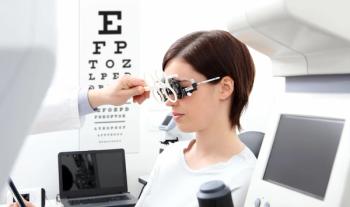
Lack of symmetry can be a red flag, but also validates accuracy of data
Interocular symmetry in average keratometry, pachymetry, and posterior elevation are useful screening tools for corneal pathology.
"As optometrists, we look at numbers all day long, and we make decisions based on these numbers. Any little pearl that we can come up with that gives us more confidence in our measurements and in our numbers will make us more accurate clinically," said Dr. Myrowitz, who is with The Wilmer Eye Institute at Green Spring Station in Lutherville, MD.
He shared with the audience a few pearls for taking corneal measurements that can be used effectively to screen for possible ocular pathologies.
Dr. Myrowitz conducted a retrospective study that included data from scanning slit topography (Orbscan II) on 242 eyes from 121 consecutive patients undergoing standard evaluation for consideration of elective laser vision correction surgery. The interocular symmetry between the right and left eyes was assessed using average simulated keratometry, minimum central corneal pachymetry, and posterior corneal elevation.
"With scanning slit topography, you obtain the anterior and posterior points of elevation, and then you take the difference to determine the thickness," he said.
Simulated keratometry is also obtained. "If you have in one eye, K readings of 45.00 and 47.00 and in the other eye 45.50 and 46.50, the average keratometry is 46.00 in both. You average the maximum and minimum for each eye and then compare right and left," Dr. Myrowitz added.
In this study, simulated keratometry measurements ranged from 39.9 to 48.6 D. The interocular difference in average simulated keratometry for the 121 patients was 0.47 D (standard deviation [SD]: 0.43).
"It's pretty tight data. The right and left eyes were all very similar, slightly less than a half a diopter difference," he said.
Pachymetry-OD versus OS
How did pachymetry compare between right and left eyes? The range of minimum pachymetry in this group of 121 patients was 432 µm to 628 µm. The interocular Pearson correlation coefficient for minimum central pachymetry was 0.95 (p < 0.001). Right and left eye minimum pachymetry differed by an average of 8 µm (SD: 7).
"It was also very close. There really is a high interocular symmetry with pachymetry," Dr. Myrowitz said.
The range of posterior elevation was -4 µm to 54 µm. The average difference in posterior corneal elevation between the right and left eye was 6 µm (SD: 5). The interocular Pearson correlation coefficient for posterior corneal elevation was 0.72 (p< 0.001). The average posterior elevation was 19 µm (SD: 11).
Measurement guide
The numbers that Dr. Myrowitz obtained from this study can be used as a guide when measuring for interocular symmetry between the right and left eye:
"Here are actual hard numbers to help you determine the interocular symmetry between the right and left eyes," he said.
"If I have more than 1 or 2 standard deviations from these numbers in my measurements, I repeat them. If repeatable, this asymmetry brings up a red flag, and I have to consider that some sort of pathology is occurring in the eye to make it abnormal," Dr. Myrowitz said.
If the interocular pachymetry deviates too much, then pay careful attention to anterior and posterior topography, he advised. If the keratometry deviates too much-if one eye has much more curvature than the other-that eye may be affected by an early form of keratoconus, he added.
"This data, in addition to being a pathology screen, can validate that you have accurate data. It has happened when I obtain repeat measurements, the original data had an error and the second measurement restored the expected symmetry and now I can have more confidence in the data," Dr.Myrowitz said in conclusion.
FYI
Elliott Myrowitz, OD, MPHPhone: 410/583-2802
E-mail:
Dr. Myrowitz did not indicate a financial interest in the subject.
Newsletter
Want more insights like this? Subscribe to Optometry Times and get clinical pearls and practice tips delivered straight to your inbox.
















































.png)


